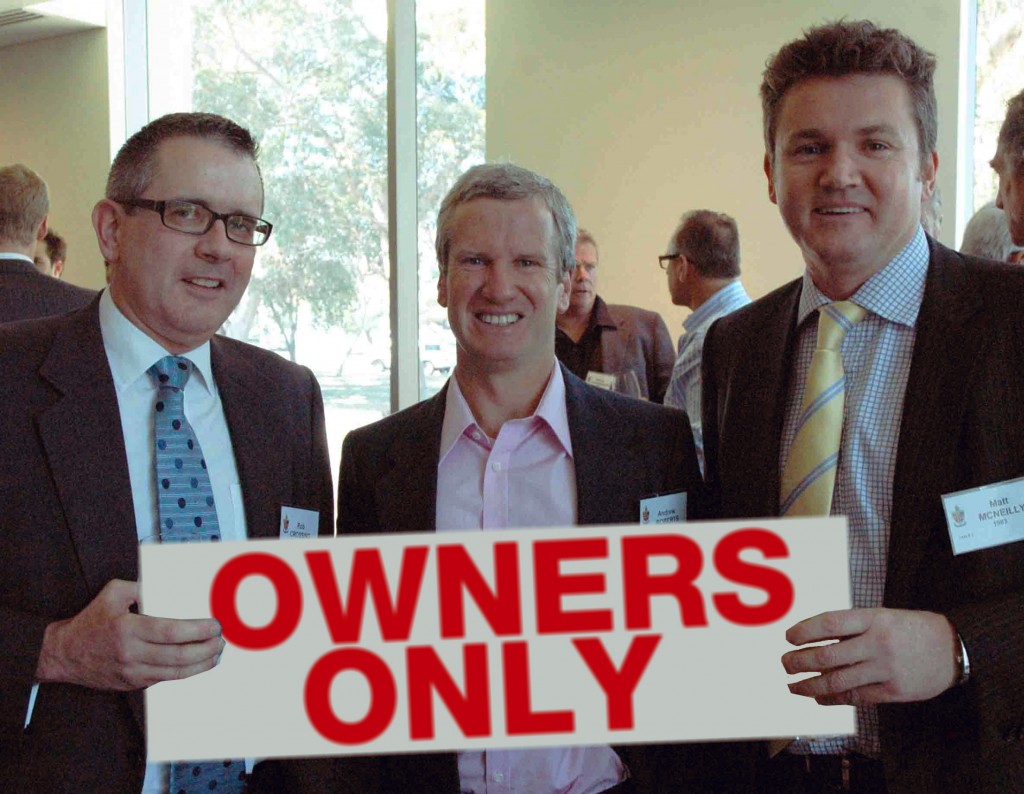Are conferences a thing of the past? Low attendance is no longer just a trend, a temporary response triggered by a tough economy. Lethargic industry-participation is the new reality. Once packed ballrooms and busy, electric hallways are becoming ghost-towns at many conferences. How long will the remaining attendees keep coming back for more? How long can conferences struggle to survive before they are put out of their misery?
If you are a conference organizer or loyal attendee and your event is failing, how can you dramatically and quickly bring back the crowds and the excitement? And if your event is thriving, an exception that proves the rule, how do you avoid losing your momentum like so many others have done?
I don’t have the answer, but the way forward must surely start with understanding the root of the failure. I humbly submit my…
Top 5 Reasons Conferences are Dead.
1. Misery Does NOT Love Company.
It would be easy (and obvious) to say, “It’s the economy, stupid!” Why over-complicate things? Businesses can’t afford to do everything they once did. They have cut back. Some have dropped out of conferences altogether; others have scaled back. When the good times roll, they’ll be back.
But I don’t find this explanation satisfying. It may be true, but it doesn’t help conference organizers know what they can do to fix the problem. It’s basically an abdication of responsibility to forces outside anyone’s control. It is far more useful, yet less comforting, to admit, “The people we want to attend don’t see value in what we offer. If they did, they would come.” The marketplace has spoken. The bad economy has forced businesses to prioritize. Guess what? Business education and conferences weren’t a high priority. Why is that?
They must not see the value.
We should not give in to the temptation to blame the reluctant customer, even though it’s justified. Yes, business decision-makers are foolish to put the brakes on education, innovation and progress. Why stop the flow of new ideas when what you need most is new ideas? It is irrational to retreat into isolation at the exact moment the opposite is called for. But if your industry is suffering through a “Dark Age,” you’ll make little progress in sparking a “Renaissance” by castigating the non-participators.
The “Age of Enlightenment” starts with shining light on that which is most valuable. Return to first principles. Rediscover why it is you have a conference to begin with.
Action steps. You have a decision to make: do you attempt to convince the non-attendees or do you refocus on the attendees? Who’s value do you seek to uncover, understand and enhance? If you want to get non-believers to participate, you must find out why they don’t see value in your conference/association/event. And what do they value? If it’s not worth their time, they won’t attend. At the same time, you can’t neglect what your core, loyal attendees value. They may not be the same. It is probably unwise to try to truly understand both.
Also, consider how you can sell your conference to decision-makers when the value is most clearly seen. This is likely to be during or immediately after the event itself, before the notepads full of great ideas and the dreams of change are buried back at the office. Post-conference euphoria and its sudden decline is well-known, and it is the root cause of my second reason Conferences Are Dying.
2. Disillusionment: It’s not what you know; it’s what you do.
Many business leaders decide against attending a conference because they haven’t put into practice all the things they learned at the last conference they went to. They think, “Why go get more ideas, however good they are, when I still haven’t implemented all (any of) the good ideas I got last year?” Ideas are cheap and easy to come by. It’s what you do with ideas that matters. If your past attendees can’t point to tangible improvements your conference made in their business or personal lives, why should they return for more?
A corollary to this problem is repetition. Same topics. Same speakers. Same people. Same information. Do your session titles sound like this? “Your people are your greatest asset.” “Time management: reclaim your life.””Engaging your team.” “Revitalizing corporate culture.” “Facebook and social media: what does it mean for business?” As important as these topics are, it can be a turn-off if people think they’ve heard it all before.
Action steps. How do you ensure attendees implement what they learn, and remember they learned it from you? Is there a way to have specific goal setting and ongoing accountability (which lasts past the post-conference euphoria) a part of their conference experience? How do you make them hungry for more, not overwhelmed by their inability to digest what you’ve already given them? And how to you make them interested in a meal they’ve already tasted? It is important to also consider making the social and relational aspects as important or more important than the education/content. Build and maintain a sense of community. Church attendees keep going back every week not because they’ll hear something new (since the Truth is timeless) but because they know they need to hear it again and again…AND they have a community that helps them on their journey. How can you build a supportive, sharing community? Answer these questions and your conference will prove its value and stave off disillusionment.
3. Unsocial Networks.
Connected. We are always connected. Smartphones and WiFi, texting and status updates. Email, Facebook and Twitter constantly bombard us. We follow and are followed, but where is “Social Networking” really leading us? While technology allows us to connect with more people more frequently, our expanding connections have spread us thin, shortened our attention spans and allowed us to retreat into an isolationist stance with a veneer of participation. We are lurkers online, voyeurs happy to observe from a comfortable distance.
Potential conference attendees think: “I can read the blogs of the speakers. I can watch them on YouTube and follow them on Twitter. I can network more effectively on LinkedIn. I can connect more deeply on Facebook than I can during a five minute coffee break between sessions. I don’t need to go.”
Here’s the irony of social networking: it tends to make us unsocial.
Action steps: Social media and its constant connection isn’t going away, but there will likely be a backlash from many who feel the need to connect old-school style: face-to-face. Be ready for this awakening. How can you position your conference to be the logical place for web-connected networks to gather in real life? How can you co-exist with social media, not in competition with it? Find a poster child or two. Can you identify a few key people who became somewhat dissatisfied with the depth of relationships they had online, and your conference allowed them to connect on a deeper, more meaningful level with people they cared about–not strangers but people they “sort-of” knew from the web? And how can you tell their story? And what do you offer that can’t be found on YouTube or in blogs?
4. Uncomfortably Commercial.
One way over-connected people are dealing with the deluge of data, updates and emails is by tuning out the noise. We’ve got spam filters, caller id, Tivo and Netflix. They’re defense mechanisms to keep us from going insane, and the only way you’re going to get past someone’s defenses is to invade their lives, trick them or get their permission to enter. (I think it’s obvious which one you should choose.) But the net result is we are now more annoyed when presented with unavoidable, unwanted commercial messages. We are used to fast-forwarding through ads, bouncing unwanted emails and hitting the ignore button. So when an attendee sits through an infomercial disguised as a keynote speech or a “lunch and learn” that’s really a “sell-my-stuff to a captive audience,” it’s not going to go over too well.
Many conferences, faced with declining income from attendance fees and hotel rooms, have loosened the constraints on their sponsors and speakers. This is understandable. Get more sponsors and let them have more time to sell and you get more money. But it’s probably the wrong decision.
Who wants to be a captive audience? If your conference has become more sponsor dependent and controlled, you are probably losing your credibility as quickly as you’re losing attendees.
Action steps: Forget about sponsors. Sounds radical, but you should try it if only as a mental exercise. Focus on the value your attendees get from your conference. Care first about their experience. Make it work for them. Delight the audience. If you have a conference that exists for the benefit of sponsors, you have it backwards.
5. Accidentally Inflexible.
The number one reason conferences are failing? Hotel contracts.
Healthy, sustainable conferences must be able to grow and contract. Suppose there is a life cycle to events and conferences. They start small, with a core group of impassioned, true-believer attendees. It becomes obvious to the outside world that something special happens when this group gets together. More firms flock to attend. Sponsors gladly sign up to get their names in front of the audience. At some point, perhaps over several years or even over decades, the core group that was the heart of the conference moves on, or are diluted to such an extent that the life leaves the party. Attendance wanes, until either the conference finally dies or re-invents itself with another, smaller core group of impassioned true-believers. And the cycle continues. (It may very well be possible to avoid the decline by ensuring the core is healthy and constantly improved.)
What keeps a conference or event from scaling down, retrenching and reinventing? Their hotel contracts. Somebody signed a five-year agreement to fill a thousand rooms and rent a large conference space. And that’s not the only constraint preventing change. The sponsors have been promised big attendance numbers. And what about the speakers? How can we afford the big-names if we don’t have a lot of attendees? How can we get a lot of attendees if we don’t have big name speakers?
All the commitments (contractual and implied) that organizations and conferences make probably seem like good business. Cheaper rooms. Better speakers. More sponsors. But when you don’t plan for decline–when you can’t scale down–you are inflexible. Which means you’ve lost control. Which means you’ll fail.
Action steps: Kill your sacred cows. Don’t worry that others will think you’re desperate. You should be. Right-size your conference. How can you assemble the best and brightest of your industry? Consider making the conference exclusive, maybe even by invitation only for a few years. Raise the price of admission. Comp the most influential people who are guaranteed to amaze their fellow attendees. A bit too radical? Maybe start a new conference as a sort of life raft for your larger, struggling conference. Maybe it should be an “unconference?” Focus less on getting a lot of people willing to pay to attend. Instead, focus on getting the right people.
Summary
Are conferences a thing of the past? Probably not, but yours might be if you don’t understand the value you offer attendees, not sponsors. Define the value, communicate the value and scale the event down to as few attendees as possible. Then get ready to grow.
Thanks for reading! Share your thoughts with me by leaving a comment or sending me an email.
~Art






 Spring Meadow Nursery
Spring Meadow Nursery


